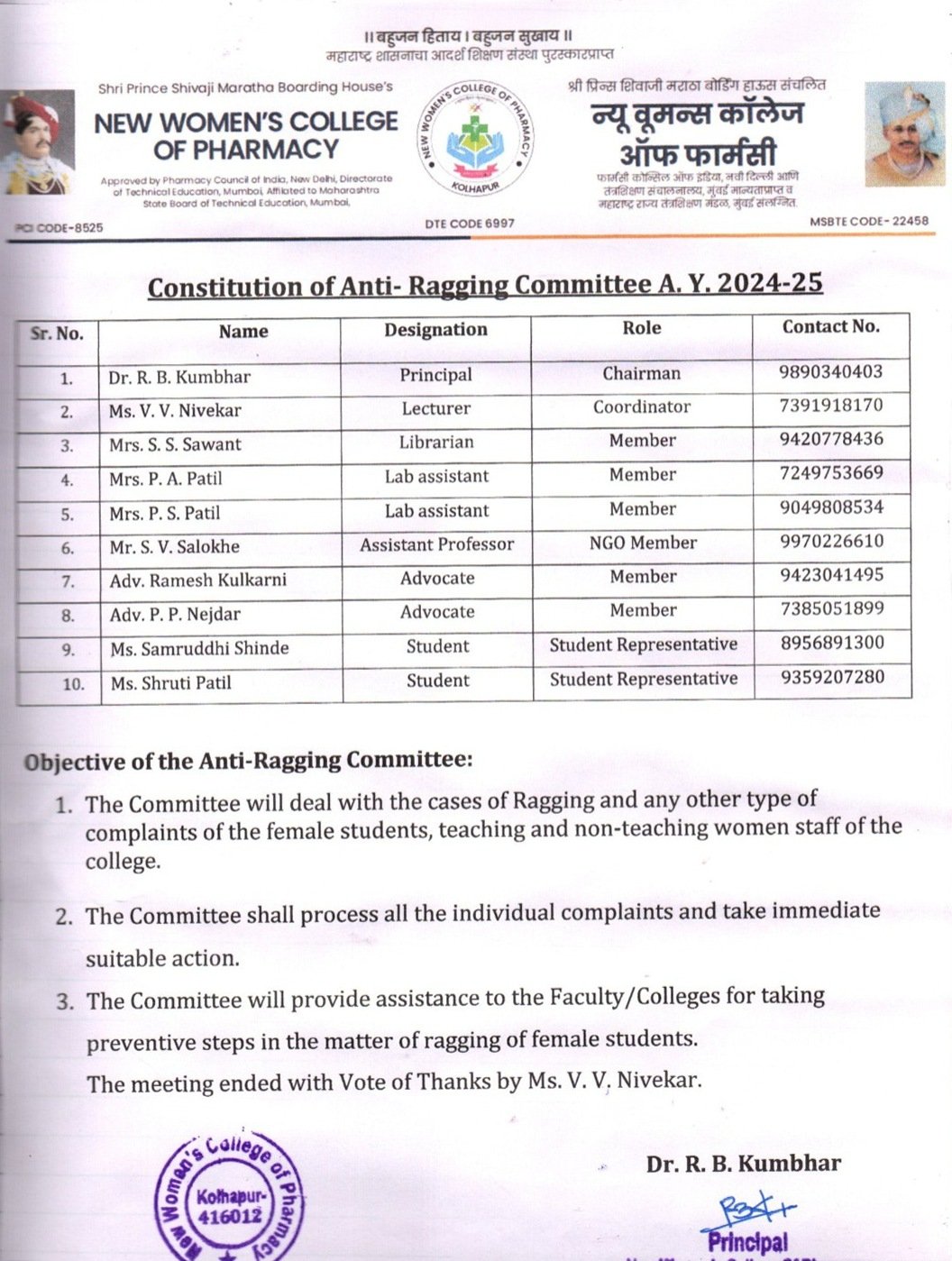Constitution for Anti-Ragging Committee

| Sr. No. | Name | Designation | Role | Contact No. |
| 1. | Dr. R. B. Kumbhar | Principal | Chairman | 9890340403 |
| 2. | Ms. V. V. Nivekar | Lecturer | Coordinator | 9130911175 |
| 3. | Mrs. S. S. Sawant | Librarian | Member | 9420778436 |
| 4. | Mrs. P. A. Patil | Lab assistant | Member | 7249753669 |
| 5. | Mrs. P. S. Patil | Lab assistant | Member | 9049808534 |
| 6. | Mr. S. V. Salokhe | Assistant Professor | NGO Member | 9970226610 |
| 1. | Adv. P. P. Nejdar | Advocate | Member | 7385051899 |
| 7. | Ms. Harshada V. Patil | Student | Student Representative | 9021495267 |
| 8. | Ms. Sonal M. Wadangekar | Student | Student Representative | 9404277565 |
The Anti-Ragging Committee in the “New Women’s College of Pharmacy” plays a crucial role in ensuring a safe, supportive, and respectful environment for students, free from any form of ragging or harassment. Here are its functions, goals, roles, and duties:
Function:
a. Prevention of Ragging:
- Develop and implement strategies to prevent ragging, bullying, harassment, and any other forms of misconduct or intimidation within the college campus.
- Raise awareness among students about the consequences of ragging and the importance of maintaining a positive and respectful learning environment.
b. Complaint Handling:
- Receive and promptly investigate complaints related to ragging, bullying, or harassment from students, faculty, staff, or other members of the college community.
- Ensure confidentiality and anonymity for complainants and witnesses involved in reporting incidents of ragging.
c. Education and Awareness:
- Organize orientation programs, workshops, and awareness campaigns to educate students about the legal implications and negative effects of ragging.
- Provide information on college policies, procedures, and support services available for preventing and addressing ragging incidents.
d. Support and Counseling:
- Offer support and counseling services to victims of ragging, ensuring their well-being, safety, and emotional support.
- Facilitate access to medical, psychological, or legal assistance for victims who require additional support or intervention.
e. Enforcement of Policies:
- Enforce college policies, regulations, and anti-ragging guidelines to deter and address incidents of ragging effectively.
- Collaborate with college administration, faculty, and security personnel to monitor and enforce compliance with anti-ragging measures.
Goals:
a. Zero Tolerance:
- Achieve zero tolerance for ragging and any form of harassment or intimidation within the college campus, fostering a culture of respect, dignity, and inclusivity.
b. Student Safety:
- Ensure the safety, well-being, and mental health of students by preventing and addressing ragging incidents promptly and effectively.
- Create a conducive learning environment where students feel secure, supported, and empowered to report any instances of ragging without fear of reprisal.
c. Awareness and Education:
- Raise awareness among students, faculty, and staff about the harmful effects of ragging and the importance of promoting positive interpersonal relationships and mutual respect.
- Empower students to take a stand against ragging and actively participate in efforts to prevent and address such incidents.
d. Compliance and Accountability:
- Ensure compliance with anti-ragging laws, regulations, and directives issued by regulatory authorities, such as the University Grants Commission (UGC) or All India Council for Technical Education (AICTE).
- Hold perpetrators of ragging accountable for their actions and impose appropriate disciplinary measures, including suspension or expulsion, in accordance with college policies and legal requirements.
Role:
a. Policy Development:
- Develop and review college policies, guidelines, and protocols related to ragging prevention, reporting, and disciplinary action.
- Ensure that policies are aligned with the provisions of the Anti-Ragging Act and other relevant legal frameworks.
b. Complaint Handling:
- Receive and investigate complaints of ragging, ensuring that due process is followed and appropriate action is taken to address reported incidents.
- Maintain confidentiality and protect the identities of complainants and witnesses involved in reporting ragging incidents.
c. Awareness and Training:
- Conduct orientation programs and workshops to educate students, faculty, and staff about the college’s anti-ragging policies, procedures, and the consequences of non-compliance.
- Provide training to committee members, faculty advisors, and student leaders on recognizing, preventing, and responding to ragging incidents effectively.
d. Monitoring and Evaluation:
- Monitor the effectiveness of anti-ragging measures and interventions through regular assessment, feedback, and evaluation.
- Review and analyze trends in ragging incidents, complaints, and disciplinary actions to identify areas for improvement and inform future prevention strategies.
Duties:
a. Complaint Registration:
- Establish mechanisms for students to report incidents of ragging, including anonymous reporting channels, complaint boxes, or online platforms.
- Ensure that complaints are registered promptly and investigated thoroughly, following established procedures and protocols.
b. Investigation and Action:
- Conduct impartial and transparent investigations into reported ragging incidents, interviewing witnesses, collecting evidence, and documenting findings.
- Take appropriate disciplinary action against individuals found guilty of ragging, including imposing sanctions, counseling, or referral to law enforcement authorities as necessary.
c. Support Services:
- Provide support and assistance to victims of ragging, including access to counseling, medical treatment, and legal advice.
- Facilitate the reintegration of victims into the college community and monitor their well-being to prevent further victimization or retaliation.
d. Coordination and Collaboration:
- Collaborate with college authorities, student organizations, local authorities, and relevant stakeholders to coordinate efforts in preventing, reporting, and addressing ragging incidents.
- Liaise with regulatory bodies, such as the UGC or AICTE, and comply with their directives and guidelines on ragging prevention and redressal.
By fulfilling these functions, goals, roles, and duties, the Anti-Ragging Committee in the “New Women’s College of Pharmacy” can effectively prevent and address incidents of ragging, ensuring a safe and supportive learning environment for all students.

